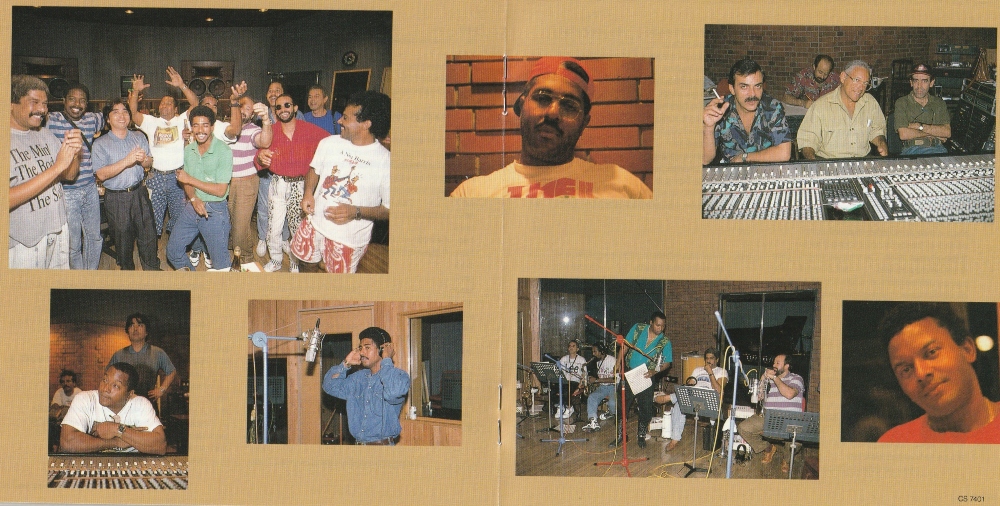
LA BRUJA
NG La Banda
1994
1. Te Pongo Mal, camara
2. Mañana
3. La Película del Sábado
4. Ya Llegó la Hora
5. All of Me
-S. Simons-G. Marks-
6. Marinero soy
7. Un Sueño Terrible
8. La Bruja
All Songs Written by José Luis Cortés except “All of Me”
When the Berlin Wall fell, it wasn’t just the political structure of the Cold War that ended. It feels like music genres and categories have disappeared into nothingness. In other words, it seems that the competing schema of “European culture” and “American pops” is no longer there.
For example, I don’t think there is any line between Jimi Hendrix and Daniel Barenboim as artists anymore. There are just some great musicians and some other craps.
Although political conflicts with the United States are the main reason, little is known about the musical situation in Cuba. Even for avid Latin fans, it is quite difficult to obtain current accurate information.
As everyone knows, pre-revolutionary Cuba was a treasure trove of beats and dance steps.
It is still fresh in our memories that songs such as the rumba (called son in Cuba), mambo, and cha-cha-cha spread throughout the world.
Well, what happened after the revolution?
Cuba’s music scene changed in many ways after the revolution, but the biggest and most important difference from before the revolution was in ”education.”
Before the Revolution, musicians had little musical education. This is because it was necessary to earn money by appearing in nightclubs and cabarets as early as possible. After the revolution, several art universities were established in Cuba, where classical professors from the Czech Republic and Hungary were invited, and talented children received nearly ten years of free education.
Originally, the roots of Cuban music were a fusion of Spanish music, centered on Gypsy music, and Afro music, centered on Nigeria, but after the revolution, classical techniques were added to it. The orchestras that emerged from this musical situation and assumed leadership were “Los Van Van” with Juan Formell, and “Irakere” with Chucho Valdes.
The two bands repeatedly experimented with music: rock/Cuban fusion, jazz/Afro-Cuban fusion, etc. In particular, ”Irakere” attracted attention at various jazz festivals and even won a Grammy Award.
Then, through these two groups, a genius emerges who creates his own band.
His name is José Luis Cortes. He has the nickname “Tosco”. He is a flutist, lyricist/composer, arranger, and band leader (also a dancer). “Tosco” joined Los Van Van at the age of 18 and remained with them for ten years. After that, he stayed at Irakere for six years, and the flute improvisations he left behind during that time were all incredible.
In 1986, ”Tosco” gathered his contemporaries and repeated the jazz fusion experiments known as the ”Siguro” and ”Ciclo” series.
The group was called the New Cuban All Stars and was later officially named “Nueva Generación La Banda” (The Band of New Generation).
As is evident in baseball and boxing, it is no mean feat to declare a ”new generation” in Cuba, where the base is wide and deep, and there are senior big-name star musicians.
Without overwhelming talent and leadership, no one will follow.
”Tosco” had formidable flute playing skills, a talent for composition and arrangement that included jazz and classical methodologies, a strong personality, and a love for Cuban music.
Cuba’s leading vocalists and musicians have gathered together under him. Among them, keyboardist Miguel Ángel, bassist Feliciano Arango, drummer Callisto Oviedo, four horn players, and vocalist Tony Cala are undoubtedly Cuba’s best talents.
NG La Banda is a super band that combines the strength of an African wild animal, the precision of a precision machine, and beautiful melody lines.
When genres and categories collapse, authenticity is needed. NG La Banda is like Cuba’s national baseball team.
It goes far beyond the concept of salsa and reveals the true meaning of the word “fusion.”
Ryu Murakami

José Luis Cortés (Voz/Flaute)
Tony Calá(Voz)
Mariano Enrique Mena(Voz)
José Miguel Crego (Trompeta)
Elpidio Chappottin (Trompeta)
Rafael Miguel Jenkes (Tenor)
Roland Pérez Pérez (Saxófono Alto)
Miguel Angel de Armas (Teclado)
Rodolfo Argudin (Piano)
Feliciano Arango(Bajo)
Calixto Oviedo (Bateria/Coro)
Humberto Sosa Acosta (Tumbadora)
Pablo Cortés (Bongo)
Guillermo Amores (Güiro)
Produced by : Ryu Murakami
Sound Produced by : José Luis Cortés
Recorded & Mixed: Ramón Alom Suarez : Sinpachirou Kawada (Music Inn)
Mastering Engineer: Kazumi Sugiura (Sony Records)
Art Direction & Design: Tomoaki Sakai (Blancchic)
Illustration: Harumi Yamaguchi
Photographer: Atsushi Kondou
Translator: Yukiko Yoshino
Production Service: Ayuko Yamada (Sony Records)
Promotion : Naoko Kodama (Sony Records), Mamiko Kuroda (Sony Records)
Supervisor: Ikuo Nabeta, Tamio Suzuki (Sony Records)
Special Thanks to Genichi Yamamoto (Shueisha), Takuro Kawanabe (Music Inn), Hiroshi Nobue (TFM), Motomitsu Tada (TFM), Haruhiko Kouno, Sadayuki Kurawaka (SMASH)
Recorded at Music Inn Yoyogi Studio, 1993. 8